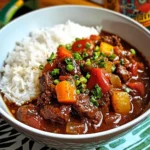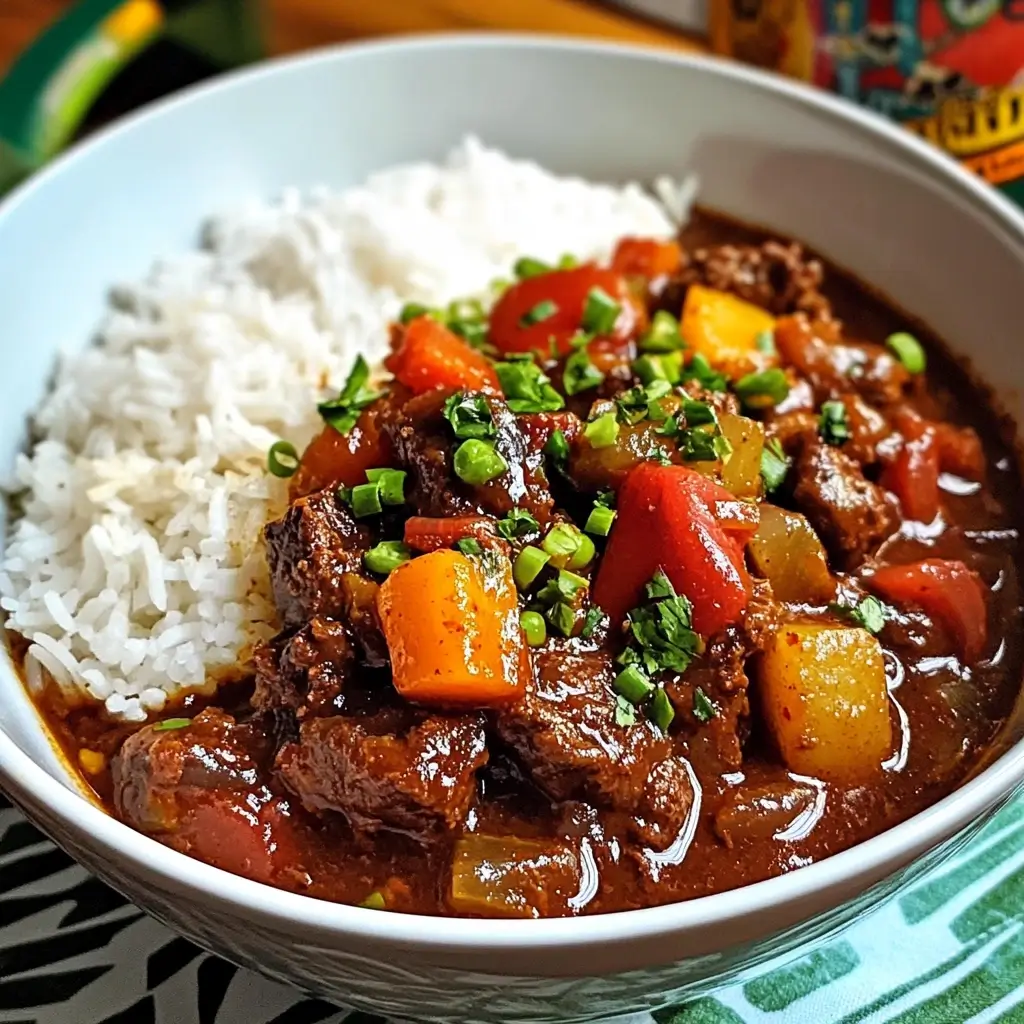There are certain dishes that just wrap you in a warm hug, transporting you somewhere else entirely with just one bite. For my family and me, this Jamaican Beef Stew is exactly that kind of magic. The first time I tackled this recipe, the aroma alone filled the house with an intoxicating blend of spices – the warm embrace of allspice, the gentle hum of thyme, and that distinct, fruity heat from the Scotch bonnet pepper. By the time dinner rolled around, anticipation was high. Seeing my partner’s eyes light up and my kids eagerly scooping up seconds (even asking for more gravy for their rice!) was the ultimate confirmation: this wasn’t just dinner, it was an experience. The beef, simmered to perfection, was incredibly tender, practically melting in the mouth, swimming in a rich, deeply flavored gravy that clung beautifully to fluffy white rice. It’s become a staple for chilly evenings, celebratory meals, or anytime we crave a taste of the Caribbean sun. It’s more than just a stew; it’s comfort, warmth, and a guaranteed crowd-pleaser that brings a little bit of island soul right into our kitchen.
**Jamaican Beef Stew: Ingredients for Island Comfort**
This recipe yields a generous portion, perfect for a family meal or for delicious leftovers. Precision isn’t always the Jamaican way, so feel free to adjust seasonings slightly to your preference, but these amounts provide a fantastic starting point for authentic flavor.
- For the Beef & Marinade:
- Beef: 2.5 – 3 lbs (approx. 1.1 – 1.4 kg) Stewing Beef (Chuck roast, round roast, or brisket flat work well), cut into 1.5 to 2-inch cubes
- Browning Sauce: 2 Tablespoons (like Kitchen Bouquet or Grace Browning Sauce)
- Soy Sauce: 1 Tablespoon (low sodium preferred)
- Worcestershire Sauce: 1 Tablespoon
- Green Scallions (Spring Onions): 4 stalks, roughly chopped
- Fresh Thyme: 4-5 sprigs (or 1.5 teaspoons dried thyme)
- Garlic: 5-6 cloves, minced or crushed
- Ginger: 1-inch piece, grated or finely minced
- Allspice (Pimento): 1 teaspoon ground allspice (or 8-10 whole pimento berries, lightly crushed)
- Black Pepper: 1 teaspoon freshly ground
- Salt: 1 teaspoon (adjust later as needed)
- Scotch Bonnet Pepper: 1 whole (or Habanero), pierced a few times with a fork OR finely minced (remove seeds/membrane for less heat – use gloves!) – optional but highly recommended for authentic flavour
- For the Stew:
- Cooking Oil: 2-3 Tablespoons (Vegetable, canola, or coconut oil)
- Onion: 1 large, chopped
- Bell Pepper: 1 large (any color – red, yellow, or green), chopped
- Carrots: 3 medium, peeled and cut into 1-inch thick rounds or chunks
- Potatoes: 2 large (approx. 1.5 lbs / 700g) waxy potatoes (like Yukon Gold or Red Bliss), peeled and cut into 1.5-inch chunks
- Tomato Paste: 2 Tablespoons
- Beef Broth or Stock: 4-6 cups (1 – 1.5 Liters), preferably low sodium
- Coconut Milk (Optional but adds richness): 1/2 cup (full fat recommended)
- Ketchup: 2 Tablespoons (adds a touch of sweetness and tang)
- Bay Leaf: 1 large
- Lime Juice: 1 Tablespoon (freshly squeezed, add at the end)
- Flour (Optional, for thickening): 2 Tablespoons all-purpose flour (can mix with a little water to make a slurry later if needed)
- Water: As needed, to adjust consistency
- For Serving:
- Cooked Rice: Steamed white rice, or traditional Jamaican Rice and Peas (see ‘How to Serve’ section)
- Fresh Parsley or Cilantro: Chopped, for garnish (optional)
- Extra Sliced Scallions: For garnish (optional)
**Instructions: Simmering Your Way to Jamaican Perfection**
Follow these steps carefully for fall-apart tender beef and a gravy bursting with flavour. Patience during the simmering stage is key!
- Marinate the Beef (Essential Step!):
- Pat the cubed beef dry with paper towels. This helps in getting a good sear later.
- In a large bowl, combine the beef cubes with all the marinade ingredients: browning sauce, soy sauce, Worcestershire sauce, chopped scallions, thyme sprigs (or dried thyme), minced garlic, grated ginger, ground allspice (or crushed berries), black pepper, salt, and the whole pierced Scotch bonnet pepper (if using whole). If using minced pepper, add it here too.
- Mix thoroughly, ensuring every piece of beef is coated. Use your hands (wear gloves if you handled minced Scotch bonnet!) for best results.
- Cover the bowl tightly with plastic wrap and refrigerate for at least 2 hours, or preferably overnight (up to 24 hours) for maximum flavour infusion.
- Prepare for Searing:
- Remove the marinated beef from the refrigerator about 30-60 minutes before cooking to allow it to come closer to room temperature.
- Pick out the whole Scotch bonnet pepper (if used) and set it aside. You’ll add it back later. Also, try to brush off most of the solid marinade bits (scallions, thyme sprigs) from the beef cubes, setting them aside too – you don’t want these burning during searing. Reserve any liquid marinade in the bowl.
- Sear the Beef (Building Flavour):
- Heat the cooking oil in a large, heavy-bottomed pot or Dutch oven over medium-high heat. The oil should shimmer but not smoke violently.
- Optional step for thicker gravy: Lightly dredge the beef cubes in the 2 tablespoons of all-purpose flour, shaking off any excess.
- Carefully place the beef cubes in the hot pot in a single layer, ensuring not to overcrowd the pan (work in batches if necessary). Sear the beef for 3-4 minutes per side, until deeply browned and crusty. A good sear develops immense flavour (Maillard reaction).
- Remove the seared beef from the pot with a slotted spoon and set aside on a plate. Don’t worry if it’s not cooked through; it will finish cooking during simmering.
- Sauté the Aromatics:
- Reduce the heat to medium. Add the chopped onion and bell pepper to the pot (add a splash more oil if the pot looks dry). Sauté for 5-7 minutes, scraping up any browned bits (fond) from the bottom of the pot – this is pure flavour! Cook until the onions are softened and translucent.
- Add the reserved marinade solids (scallions, thyme, garlic from the marinade bowl) and the tomato paste. Cook for another 1-2 minutes, stirring constantly, until the tomato paste darkens slightly and becomes fragrant.
- Deglaze and Combine:
- Pour about 1 cup of the beef broth into the pot. Bring it to a simmer, scraping vigorously at the bottom of the pot with a wooden spoon to release all those delicious browned bits.
- Return the seared beef (and any accumulated juices from the plate) to the pot.
- Add the remaining beef broth, the reserved liquid marinade, the optional coconut milk, ketchup, and the bay leaf. Stir everything together.
- Add back the whole Scotch bonnet pepper you set aside earlier (if using). Ensure it remains whole so you can easily remove it later. If you prefer controlled heat, you can leave it out now and add it only for the last 30-60 minutes of simmering.
- Simmer Low and Slow (The Magic Happens Here):
- Bring the stew to a gentle simmer. Once simmering, reduce the heat to low, cover the pot tightly, and let it cook for at least 1.5 hours. The key is a very gentle bubble, not a rolling boil. Stir occasionally to prevent sticking.
- The goal here is to tenderize the beef. Tougher cuts need this long, slow cooking time.
- Add Vegetables:
- After 1.5 hours (or when the beef is starting to become tender when pierced with a fork), stir in the chopped carrots and potatoes. Ensure they are mostly submerged in the liquid. If the stew looks too thick, add a little hot water or more beef broth. If it looks too thin, don’t worry, it will thicken as the potatoes cook and release starch, and you can adjust later.
- Put the lid back on and continue to simmer for another 45 minutes to 1 hour, or until the vegetables are tender and the beef is fall-apart soft.
- Final Touches & Adjustments:
- Carefully remove and discard the whole Scotch bonnet pepper (or fish out the thyme sprigs and bay leaf if desired). Be careful not to break the pepper open unless you want extreme heat!
- Taste the gravy. Adjust seasoning as needed with more salt, black pepper, or even a pinch more allspice if desired.
- Stir in the fresh lime juice. This brightens up the rich flavours wonderfully.
- Check Gravy Consistency: If the gravy is thinner than you like, you can thicken it. Mix 1-2 tablespoons of flour or cornstarch with 2-3 tablespoons of cold water to create a smooth slurry. Stir the slurry into the simmering stew and cook for a few more minutes until the gravy thickens. Alternatively, remove the lid and let the stew simmer gently for 10-15 minutes to reduce and thicken naturally.
- Rest and Serve:
- Turn off the heat and let the stew rest for 10-15 minutes before serving. This allows the flavours to meld even further.
- Serve hot, generously spooned over fluffy white rice or Jamaican Rice and Peas. Garnish with chopped fresh parsley, cilantro, or extra sliced scallions if desired.
**Nutrition Facts**
- Servings: This recipe generously serves 6-8 people.
- Calories per Serving (Estimate): Approximately 550-750 kcal per serving (excluding rice).
Disclaimer: Nutritional information is an estimate only and can vary significantly based on specific ingredients used (e.g., fat content of beef, use of coconut milk, type of oil), portion sizes, and cooking methods. This estimate does not include the accompanying rice or other side dishes. For precise nutritional information, please use your preferred nutrition calculator with your exact ingredients and measurements. This stew provides a good source of protein, iron, and various vitamins from the vegetables.
**Preparation Time**
Understanding the time commitment helps plan your cooking:
- Marinating Time: 2 hours (minimum) to 24 hours (recommended for best flavour)
- Prep Time (Chopping, Searing): Approximately 30-45 minutes
- Cook Time (Simmering): Approximately 2.5 – 3 hours (1.5 hours for beef + 45-60 mins with vegetables)
- Resting Time: 10-15 minutes
- Total Active Time: Roughly 1 hour 15 minutes
- Total Time (excluding marinating): Approximately 3 to 3.5 hours
While it requires a significant simmering time, most of this is hands-off, allowing the stew to develop its deep, rich flavours while you relax or prepare other parts of the meal.
**How to Serve Your Jamaican Beef Stew**
Serving this stew is almost as important as making it! Here’s how to create the perfect Jamaican-inspired meal experience:
- The Foundation – Rice:
- Jamaican Rice and Peas: This is the quintessential pairing. It’s typically long-grain white rice cooked with kidney beans (or gungo/pigeon peas), coconut milk, scallions, thyme, and sometimes a whole Scotch bonnet pepper for flavour (removed before serving). The creamy, subtly sweet and savoury rice is the perfect vehicle for the rich stew gravy. Making Rice and Peas involves soaking dried beans overnight (or using canned beans), then simmering them until tender before adding the rice, coconut milk, seasonings, and water to cook the rice.
- Plain Steamed Rice: Simple, fluffy white rice (like Jasmine or Basmati) works beautifully too. It allows the complex flavours of the beef stew to shine through without competition. Ensure it’s cooked well, so it can soak up all that delicious gravy.
- Brown Rice: For a healthier option, brown rice can be used, offering a nuttier flavour and more fiber.
- Beyond Rice – Alternative Starches:
- Roti: Soft, flaky Caribbean flatbread (like Dhal Puri or Paratha Roti) is excellent for scooping up the stew and gravy.
- Jamaican Boiled Dumplings (“Spinners”): Small, dense, elongated flour dumplings can be cooked directly in the stew during the last 20-30 minutes of simmering. They soak up the flavour and add a lovely chewy texture. To make simple spinners, mix flour with a little water and salt to form a stiff dough, then roll small pieces into elongated shapes.
- Boiled Ground Provisions: Serve alongside or instead of rice with boiled yam, dasheen (taro), green bananas, or breadfruit for a truly traditional Caribbean meal.
- Complementary Side Dishes:
- Fried Ripe Plantains: Sweet, caramelized fried plantains offer a wonderful sweet contrast to the savoury, spicy stew. Fry yellow plantains (with black spots) sliced on the diagonal in a little oil until golden brown and tender.
- Simple Green Salad: A crisp green salad with a light vinaigrette can provide a refreshing counterpoint.
- Jamaican Steamed Cabbage: Lightly steamed cabbage with carrots and sometimes saltfish adds another vegetable component.
- Creamy Coleslaw: A simple, creamy coleslaw also offers a cool, crunchy contrast.
- Garnishes and Presentation:
- Fresh Herbs: Sprinkle with freshly chopped cilantro (coriander) or parsley just before serving for a burst of freshness and colour.
- Scallions: Thinly sliced green scallion tops add a mild oniony bite and visual appeal.
- Lime Wedges: Serve with extra lime wedges on the side for those who like an extra zing.
- Serving Vessel: Serve in deep bowls to hold plenty of gravy. Make sure everyone gets a good ratio of beef, vegetables, and that luscious gravy.
**Additional Tips for Stew Success**
Elevate your Jamaican Beef Stew from great to unforgettable with these pro tips:
- Choose the Right Cut of Beef: Don’t use expensive, tender cuts like tenderloin or sirloin – they will become tough and dry with long cooking. Opt for tougher, collagen-rich cuts from the shoulder (chuck), leg (round), or chest (brisket). These cuts break down beautifully during the long, slow simmering process, becoming incredibly tender and flavourful. Cutting the beef into reasonably uniform 1.5 to 2-inch cubes ensures even cooking.
- Don’t Skip or Rush the Sear: Searing the beef over medium-high heat before simmering is crucial. This process, known as the Maillard reaction, creates complex flavours and a deep brown colour that forms the foundation of your stew’s richness. Ensure the pan is hot, don’t overcrowd it (sear in batches!), and get a good brown crust on all sides. Those browned bits left in the pot (fond) are flavour gold – make sure to scrape them up when you deglaze.
- Master the Scotch Bonnet Heat: Scotch bonnet peppers provide not just heat but also a unique fruity flavour essential to many Jamaican dishes. Handle them with care (use gloves!). For flavour without intense heat, add the pepper whole (pierced a few times) and remove it before serving. For more heat, finely mince it (removing seeds and membranes reduces heat somewhat). If you can’t find Scotch bonnets, Habaneros are the closest substitute in flavour and heat. Start with less if you’re unsure – you can always add more heat later (e.g., with a dash of hot sauce), but you can’t easily take it away.
- Embrace the Browning Sauce (Judiciously): Browning sauce is a key ingredient for achieving that characteristic deep, dark colour and subtle caramelized flavour in Jamaican stews. A little goes a long way – too much can make the stew taste slightly bitter. Brands like Grace or Kitchen Bouquet are common. If you don’t have it, you can achieve some colour by ensuring a very deep sear on the beef and thoroughly caramelizing the tomato paste, though the specific flavour profile will be slightly different.
- Make it Ahead – Flavour Improves: Like many stews, Jamaican Beef Stew tastes even better the next day! The flavours meld and deepen overnight. If you have the time, make it a day in advance, let it cool completely, store it in the refrigerator, and then gently reheat it on the stovetop or in the oven before serving. When reheating, you might need to add a splash of water or broth to adjust the consistency. This also makes it a fantastic dish for entertaining, as the main cooking is done ahead of time.
**Frequently Asked Questions (FAQ)**
Q1: Can I make Jamaican Beef Stew in a slow cooker or pressure cooker?
- A1: Absolutely!
- Slow Cooker: Follow steps 1-4 (marinating, searing beef, sautéing aromatics, deglazing) on the stovetop. Transfer everything (including the seared beef, sautéed veg, liquids, whole Scotch bonnet, bay leaf) to the slow cooker. Add the potatoes and carrots. Cook on LOW for 6-8 hours or on HIGH for 4-5 hours, until the beef and vegetables are tender. You may need to thicken the gravy at the end using a cornstarch slurry on the stovetop or by turning the slow cooker to HIGH with the lid off for the last 30 minutes. Remove the Scotch bonnet and bay leaf, stir in lime juice before serving.
- Pressure Cooker (Instant Pot): Use the ‘Sauté’ function for steps 3 (searing) and 4 (sautéing aromatics). Deglaze the pot thoroughly. Return the beef, add liquids (you might need slightly less broth, check your cooker’s manual – ensure it reaches the minimum liquid line), potatoes, carrots, whole Scotch bonnet, and bay leaf. Secure the lid, set the valve to sealing. Cook on High Pressure for 35-45 minutes (depending on the cut and size of beef chunks). Allow for a natural pressure release (NPR) for at least 15 minutes before performing a quick release. Remove Scotch bonnet/bay leaf, check seasoning, thicken with slurry on ‘Sauté’ mode if needed, and stir in lime juice.
Q2: What can I substitute for Scotch Bonnet peppers if I can’t find them?
- A2: Habanero peppers are the closest substitute, offering similar heat levels and fruity notes. If those are also unavailable, you could use a Serrano pepper (less fruity, more direct heat – use more than one potentially) or even a pinch of cayenne pepper or red pepper flakes for heat, though you’ll miss the characteristic fruity flavour profile. Start with a small amount and add more to taste. Remember to handle all hot peppers with care.
Q3: What is Browning Sauce, and is there a substitute?
- A3: Browning sauce (like Kitchen Bouquet, Gravy Master, or Grace Browning) is a dark, concentrated liquid used primarily for adding deep colour and a subtle, savoury, slightly caramelized flavour to stews, gravies, and meats. It’s often made from caramel colour, vegetable concentrates, and seasonings. If you can’t find it, you can achieve colour through a very deep sear on the beef and by carefully caramelizing the tomato paste. Some people make a homemade version by carefully caramelizing sugar (burnt sugar), but this requires caution. You could also use a tablespoon or two of dark soy sauce combined with a teaspoon of molasses for a colour and flavour approximation, but adjust salt accordingly. The stew will still be delicious without it, just lighter in colour.
Q4: How can I make this Jamaican Beef Stew gluten-free?
- A4: It’s easy to adapt!
- Skip the optional flour dredging step before searing the beef.
- Ensure your beef broth, soy sauce (use Tamari), and Worcestershire sauce are certified gluten-free, as some brands contain gluten. Lea & Perrins Worcestershire sauce in the US is generally gluten-free, but always check labels.
- If you need to thicken the stew at the end, use a slurry made from cornstarch, arrowroot powder, or tapioca starch mixed with cold water instead of a flour slurry.
Q5: My stew gravy isn’t thick enough. How can I fix it?
- A5: There are several ways to thicken your stew gravy:
- Cornstarch Slurry (Gluten-Free): Mix 1-2 tablespoons of cornstarch with an equal amount of cold water until smooth. Stir it into the simmering stew and cook for 1-2 minutes until thickened.
- Flour Slurry: Mix 2 tablespoons of all-purpose flour with about 1/4 cup of cold water until smooth. Stir into the simmering stew and cook for several minutes to cook out the raw flour taste.
- Reduction: Remove the lid from the pot and let the stew simmer gently over medium-low heat. This allows excess liquid to evaporate, concentrating the flavours and thickening the gravy naturally. This may take 10-20 minutes.
- Mash Some Vegetables: Carefully scoop out a few pieces of cooked potato or carrot, mash them well with a fork, and stir them back into the stew. The starches will help thicken the gravy slightly.
- Beurre Manié (Rich Option): Knead together equal parts softened butter and flour (e.g., 1 tablespoon each) to form a paste. Whisk small bits of this paste into the simmering stew until it melts and thickens the gravy.

Jamaican Beef Stew with Rice Recipe
Ingredients
- For the Beef & Marinade:
- Beef: 2.5 – 3 lbs (approx. 1.1 – 1.4 kg) Stewing Beef (Chuck roast, round roast, or brisket flat work well), cut into 1.5 to 2-inch cubes
- Browning Sauce: 2 Tablespoons (like Kitchen Bouquet or Grace Browning Sauce)
- Soy Sauce: 1 Tablespoon (low sodium preferred)
- Worcestershire Sauce: 1 Tablespoon
- Green Scallions (Spring Onions): 4 stalks, roughly chopped
- Fresh Thyme: 4-5 sprigs (or 1.5 teaspoons dried thyme)
- Garlic: 5-6 cloves, minced or crushed
- Ginger: 1-inch piece, grated or finely minced
- Allspice (Pimento): 1 teaspoon ground allspice (or 8-10 whole pimento berries, lightly crushed)
- Black Pepper: 1 teaspoon freshly ground
- Salt: 1 teaspoon (adjust later as needed)
- Scotch Bonnet Pepper: 1 whole (or Habanero), pierced a few times with a fork OR finely minced (remove seeds/membrane for less heat – use gloves!) – optional but highly recommended for authentic flavour
- For the Stew:
- Cooking Oil: 2-3 Tablespoons (Vegetable, canola, or coconut oil)
- Onion: 1 large, chopped
- Bell Pepper: 1 large (any color – red, yellow, or green), chopped
- Carrots: 3 medium, peeled and cut into 1-inch thick rounds or chunks
- Potatoes: 2 large (approx. 1.5 lbs / 700g) waxy potatoes (like Yukon Gold or Red Bliss), peeled and cut into 1.5-inch chunks
- Tomato Paste: 2 Tablespoons
- Beef Broth or Stock: 4-6 cups (1 – 1.5 Liters), preferably low sodium
- Coconut Milk (Optional but adds richness): 1/2 cup (full fat recommended)
- Ketchup: 2 Tablespoons (adds a touch of sweetness and tang)
- Bay Leaf: 1 large
- Lime Juice: 1 Tablespoon (freshly squeezed, add at the end)
- Flour (Optional, for thickening): 2 Tablespoons all-purpose flour (can mix with a little water to make a slurry later if needed)
- Water: As needed, to adjust consistency
- For Serving:
- Cooked Rice: Steamed white rice, or traditional Jamaican Rice and Peas (see ‘How to Serve’ section)
- Fresh Parsley or Cilantro: Chopped, for garnish (optional)
- Extra Sliced Scallions: For garnish (optional)
Instructions
- Marinate the Beef (Essential Step!):
- Pat the cubed beef dry with paper towels. This helps in getting a good sear later.
- In a large bowl, combine the beef cubes with all the marinade ingredients: browning sauce, soy sauce, Worcestershire sauce, chopped scallions, thyme sprigs (or dried thyme), minced garlic, grated ginger, ground allspice (or crushed berries), black pepper, salt, and the whole pierced Scotch bonnet pepper (if using whole). If using minced pepper, add it here too.
- Mix thoroughly, ensuring every piece of beef is coated. Use your hands (wear gloves if you handled minced Scotch bonnet!) for best results.
- Cover the bowl tightly with plastic wrap and refrigerate for at least 2 hours, or preferably overnight (up to 24 hours) for maximum flavour infusion.
- Prepare for Searing:
- Remove the marinated beef from the refrigerator about 30-60 minutes before cooking to allow it to come closer to room temperature.
- Pick out the whole Scotch bonnet pepper (if used) and set it aside. You’ll add it back later. Also, try to brush off most of the solid marinade bits (scallions, thyme sprigs) from the beef cubes, setting them aside too – you don’t want these burning during searing. Reserve any liquid marinade in the bowl.
- Sear the Beef (Building Flavour):
- Heat the cooking oil in a large, heavy-bottomed pot or Dutch oven over medium-high heat. The oil should shimmer but not smoke violently.
- Optional step for thicker gravy: Lightly dredge the beef cubes in the 2 tablespoons of all-purpose flour, shaking off any excess.
- Carefully place the beef cubes in the hot pot in a single layer, ensuring not to overcrowd the pan (work in batches if necessary). Sear the beef for 3-4 minutes per side, until deeply browned and crusty. A good sear develops immense flavour (Maillard reaction).
- Remove the seared beef from the pot with a slotted spoon and set aside on a plate. Don’t worry if it’s not cooked through; it will finish cooking during simmering.
- Sauté the Aromatics:
- Reduce the heat to medium. Add the chopped onion and bell pepper to the pot (add a splash more oil if the pot looks dry). Sauté for 5-7 minutes, scraping up any browned bits (fond) from the bottom of the pot – this is pure flavour! Cook until the onions are softened and translucent.
- Add the reserved marinade solids (scallions, thyme, garlic from the marinade bowl) and the tomato paste. Cook for another 1-2 minutes, stirring constantly, until the tomato paste darkens slightly and becomes fragrant.
- Deglaze and Combine:
- Pour about 1 cup of the beef broth into the pot. Bring it to a simmer, scraping vigorously at the bottom of the pot with a wooden spoon to release all those delicious browned bits.
- Return the seared beef (and any accumulated juices from the plate) to the pot.
- Add the remaining beef broth, the reserved liquid marinade, the optional coconut milk, ketchup, and the bay leaf. Stir everything together.
- Add back the whole Scotch bonnet pepper you set aside earlier (if using). Ensure it remains whole so you can easily remove it later. If you prefer controlled heat, you can leave it out now and add it only for the last 30-60 minutes of simmering.
- Simmer Low and Slow (The Magic Happens Here):
- Bring the stew to a gentle simmer. Once simmering, reduce the heat to low, cover the pot tightly, and let it cook for at least 1.5 hours. The key is a very gentle bubble, not a rolling boil. Stir occasionally to prevent sticking.
- The goal here is to tenderize the beef. Tougher cuts need this long, slow cooking time.
- Add Vegetables:
- After 1.5 hours (or when the beef is starting to become tender when pierced with a fork), stir in the chopped carrots and potatoes. Ensure they are mostly submerged in the liquid. If the stew looks too thick, add a little hot water or more beef broth. If it looks too thin, don’t worry, it will thicken as the potatoes cook and release starch, and you can adjust later.
- Put the lid back on and continue to simmer for another 45 minutes to 1 hour, or until the vegetables are tender and the beef is fall-apart soft.
- Final Touches & Adjustments:
- Carefully remove and discard the whole Scotch bonnet pepper (or fish out the thyme sprigs and bay leaf if desired). Be careful not to break the pepper open unless you want extreme heat!
- Taste the gravy. Adjust seasoning as needed with more salt, black pepper, or even a pinch more allspice if desired.
- Stir in the fresh lime juice. This brightens up the rich flavours wonderfully.
- Check Gravy Consistency: If the gravy is thinner than you like, you can thicken it. Mix 1-2 tablespoons of flour or cornstarch with 2-3 tablespoons of cold water to create a smooth slurry. Stir the slurry into the simmering stew and cook for a few more minutes until the gravy thickens. Alternatively, remove the lid and let the stew simmer gently for 10-15 minutes to reduce and thicken naturally.
- Rest and Serve:
- Turn off the heat and let the stew rest for 10-15 minutes before serving. This allows the flavours to meld even further.
- Serve hot, generously spooned over fluffy white rice or Jamaican Rice and Peas. Garnish with chopped fresh parsley, cilantro, or extra sliced scallions if desired.
Nutrition
- Serving Size: One Normal Portion
- Calories: 550-750





